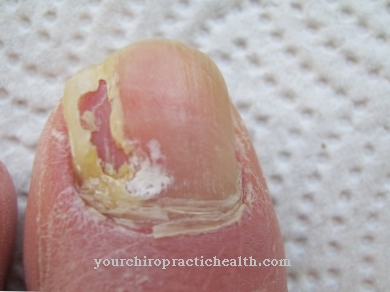As Pelvic fracture, medical Pelvic fracture, is an injury to the bony pelvic ring apparatus caused by external force. Pelvic fractures are usually well treatable within the framework of adequate treatment measures and have a good prognosis.
What is a pelvic fracture?

© Henrie - stock.adobe.com
A pelvic fracture occurs when parts of the pelvic bone apparatus are damaged. The human pelvic apparatus includes the blades of the iliac bone, the pubic bone (front part) and ischium (lower part) as well as the sacrum, which closes off the pelvis in the rear part and supports the spine.
These elements of the bone apparatus form a coherent pelvic ring that protects the internal organs. In the case of a fracture of the pelvis, this protective pelvic ring is damaged by a fracture, a distinction being made between unstable and stable pelvic fractures.
While the pelvic ring remains intact despite a fracture, mostly of the pubic or pelvic bone, in the case of a stable pelvic fracture that occurs more frequently, the ring bond is broken in the case of an unstable fracture. An unstable pelvic fracture can also affect internal organs.
causes
In most cases, stable pelvic fractures are due to a fall (e.g. from black ice). In particular, older people who already suffer from age-related osteoporosis (decalcification of the bones, bone loss) are at risk from the instability of their bones.
Therefore, older people often experience additional injuries (usually femoral neck fracture) in combination with a pelvic fracture. Unstable pelvic fractures are in most cases caused by severe externally inflicted trauma, such as car accidents or falls from a great height, and it is not uncommon for them to affect several bones of the pelvic ring (multiple trauma).
In many cases, the internal organs such as the bladder, intestinal area, blood vessels or nerves are also injured, with pelvic fractures involving the bladder being particularly dangerous.
Symptoms, ailments & signs
A typical symptom that can indicate a pelvic fracture is severe pain in the pelvic region, sometimes swelling at the fracture site or bruising. An unstable fracture usually causes more pain than a stable one. This is why a stable break is sometimes not even perceived as a break at the beginning.
The fracture creates an unstable feeling throughout the pelvis, which can possibly result in a pelvic tilt and a difference in leg length. If internal organs, which the pelvis is normally supposed to protect, are also injured in the break, genital or anal bleeding may occur, especially if the bladder, intestines or internal genital organs are injured. If nerves are injured or impaired by the break, it can also lead to sensory disturbances or problems with motor skills.
In most cases, a fracture of the pelvis also restricts movement in the legs. In worse cases, if internal organs were injured in the fracture, people may face pale pale, have a rapid pulse, suffer from anxiety, or even lose consciousness. If these symptoms occur in connection with a fall, a doctor should be called immediately.
Diagnosis & course
A pelvic fracture is diagnosed on the basis of the characteristic symptoms such as pain, swelling and possibly a lack of stability of the pelvic ring, discoloration or misalignments and blockages in the area of the hip joint as part of a physical examination.
In some cases, a pelvic fracture can cause the pelvic bones to move slightly against each other. In the differential diagnosis, stable pelvic fractures can be distinguished from unstable ones due to the less pronounced pain. Bloody urine can indicate involvement of the bladder, urethra and / or ureter.
The diagnosis is confirmed by an X-ray examination, which enables statements to be made about the location and course of the pelvic fracture, as well as by imaging procedures (sonography, computer tomography), which can be used to determine whether the internal organs have been damaged.
The course and prognosis depend on the extent of the pelvic fracture and whether the internal organs are involved. As a rule, pelvic fractures are easily curable with appropriate therapy measures.
Complications
Various complications can occur as a result of a pelvic fracture. The rupture can injure the veins or damage the bladder, urethra, vagina or anus. Nerve damage and temporary paralysis are also common consequences of a pelvic fracture. Bleeding, which is often aggravated by anti-inflammatory drugs, is one of the most common and most dangerous complications.
Diaphragmatic ruptures, muscle injuries and venous thrombosis can also occur. If the acetabulum is fractured, there are often other problems such as post-traumatic osteoarthritis or heterotropic ossification. Particularly intense trauma can lead to the death of the distant head. The consequence of a fracture can also lead to muscle wasting, weight gain and other secondary problems, which can, however, be prevented by adequate therapy.
When treating a pelvic hernia, complications such as wound healing disorders, bleeding and infections are the main complications. A fracture of the pelvis rarely leads to incontinence and impaired sexual functions. By constantly consulting the doctor and observing the body's own warning signals, complications as a result of a pelvic fracture can almost always be avoided.
When should you go to the doctor?
In the event of a fractured pelvis, a doctor must be consulted immediately. In acute emergencies or directly after an accident or after an injury, the hospital can be visited or the emergency doctor can be called directly. In this way, further and irreversible consequential damage can be avoided. If you do not see a doctor, you may experience problems when the bones grow together.
A doctor must therefore be consulted if a bone fracture is clearly visible and if the affected areas on the body are severely swollen. It is not uncommon for patients to suffer from severe pain and bruises. Furthermore, bloody urine is a clear sign of a pelvic fracture and should therefore be examined by a doctor.
The patients are significantly restricted in their movement, so ideally they should not move themselves in order to avoid further damage. Even if the person concerned loses consciousness, it is essential to see a doctor. Quick and early treatment can prevent various complications.
Doctors & therapists in your area
Treatment & Therapy
Stable pelvic fractures usually heal without complications or surgery. However, a few days of bed rest followed by early mobilization under the guidance of a physiotherapeutic specialist are indicated.
In the majority of cases, unstable pelvic fractures must first be fixed from the outside with a stabilizer (external fixator) or pelvic forceps in order to stabilize the pelvic ring and stop internal bleeding. After the bleeding has stopped, the pelvic ring can be opened as part of a surgical procedure and the loose ends of the fracture caused by the pelvic fracture can be fixed with screws or plates.
The selected surgical procedure is largely dependent on the presence of further injuries. Following the surgical procedure, depending on the surgical method chosen, two months of bed rest is indicated, whereby passive mobilization measures with a physiotherapist should be started as early as possible.
In rare cases, complications such as bleeding, wound healing disorders and infections must be treated additionally. In addition, if the nerves are involved, long-term consequences such as incontinence or impairment of sexual functions in male patients with a pelvic fracture can occur, which should be treated accordingly. After successfully completing therapy, those affected by a pelvic fracture are usually able to endure normal physical stress and perform everyday movements.
Outlook & forecast
If a pelvic fracture occurs, the chances of recovery depend very much on the extent of the injury. With a stable pelvic fracture, the chances are good that it will heal without complications and that no consequential damage will remain. An unstable pelvic fracture can also heal well if treated properly.
Problems with wound healing, secondary bleeding and infections rarely occur. Occasionally, nerves supplying the bladder and intestines can be impaired, which can lead to incontinence symptoms, and in men, sexual function can be impaired.
In addition to the degree of injury, the prognosis also depends on how old the patient is, what his state of health is and where the fracture is located. The healing time for a stable pelvic fracture is between 4 and 8 weeks. But pain can still occur even after this time.
Bed rest should be observed for the first few weeks to promote healing. With a complete pelvic fracture, patients cannot avoid surgery, especially if the hip joint is also affected. Bed rest is also required after the operation; in the case of a complicated pelvic fracture, it can even take several months before the legs can be put back to weight.
prevention
A pelvic fracture can be prevented by taking appropriate precautionary measures to protect against falls. Older people, who are particularly at risk from age-related osteoporosis and who already have impairments to the musculoskeletal system, should use walking aids such as walkers and sturdy shoes to protect themselves from pelvic fractures for safe walking.
You can do that yourself
A pelvic fracture usually has to be treated surgically. Only with a stable type A pelvic injury can the fracture be treated independently through bed rest and mobility exercises. Together with a physiotherapist, the fracture can also heal without any surgical intervention. A type B or type C pelvic injury must be cured under the supervision of a doctor.
At the same time, the healing process can be accelerated with some self-measures and home remedies. In the first few days after the injury, stimulants such as nicotine and alcohol should be avoided. A quick healing of the fracture can be achieved through protection. After a few days to weeks, light exercise and yoga can help build bones. Above all, the surrounding joints should be used again in everyday life as soon as possible in order to avoid further bone and muscle breakdown.
A proven natural remedy for broken bones is black root. The plant strengthens the injured bone and can be used either as a compress or a paste. In general, a diet rich in minerals is recommended for bone fractures. Milk and dairy products as well as unsalted dried fruit, figs, garlic, onions or bananas are suitable. Magnesium and potassium can be supplied to the body through oatmeal, asparagus, legumes or plums.

.jpg)

.jpg)








.jpg)



.jpg)










.jpg)
